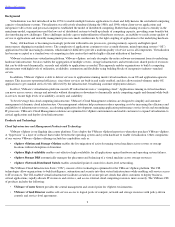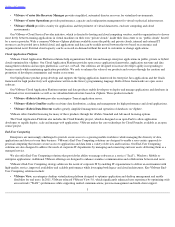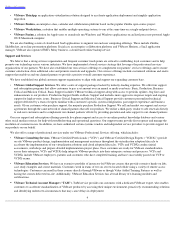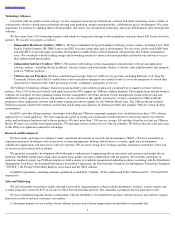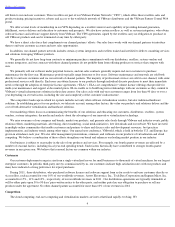VMware 2011 Annual Report Download - page 17
Download and view the complete annual report
Please find page 17 of the 2011 VMware annual report below. You can navigate through the pages in the report by either clicking on the pages listed below, or by using the keyword search tool below to find specific information within the annual report.
Table of Contents
ensure interoperability with our products and offer compatible products and services to end users. If we are unable to obtain such
cooperation, it may be difficult and more costly for us to achieve functionality and service levels that would make our new products and
services attractive to end users.
Additionally, our operating margins in our newer initiatives may be lower than those we have achieved in the markets we currently serve,
and we may not be successful enough in these newer activities to recoup our investments in them. If any of these risks were to occur, it could
damage our reputation, limit our growth and negatively affect our operating results.
Ongoing uncertainty regarding global economic conditions and the stability of regional financial markets may reduce information
technology spending below current expectations and therefore adversely impact our revenues, impede end-
user adoption of new products and
product upgrades and adversely impact our competitive position.
Our business depends on the overall demand for information technology and on the economic health of our current and prospective
customers. The purchase of our products is often discretionary and may involve a significant commitment of capital and other resources. Weak
economic conditions or significant uncertainty regarding the stability of financial markets could adversely impact our business, financial
condition and results of operations in a number of ways, including by lengthening sales cycles, affecting the size of enterprise license agreements
(“ELAs”) that customers will commit to, lowering prices for our products and services, reducing unit sales, reducing the rate of adoption of our
products by new customers and the willingness of current customers to purchase upgrades to our existing products. The ongoing sovereign debt
crisis in Europe threatens to suppress demand and our customers' access to credit in that region, which is an important market for our products
and services. Additionally, in response to sustained economic uncertainty, many national and local governments that are current or prospective
customers for our products and services have also made, or announced plans to make, spending cutbacks which could reduce the amount of
government spending on IT and the potential demand for our products and services from the government sector.
Ongoing economic uncertainty has also resulted in general and ongoing tightening in the credit markets, lower levels of liquidity, increases
in the rates of default and bankruptcy and significant volatility in the credit, equity and fixed income markets. As a result, current or potential
customers may be unable to fund software purchases, which could cause them to delay, decrease or cancel purchases of our products and
services. Even if customers are willing to purchase our products and services, if they do not meet our credit requirements, we may not be able to
record accounts receivable or unearned revenue or recognize revenues from these customers until we receive payment, which could adversely
affect the amount of revenues we are able to recognize in a particular period.
12
• We will need to develop and implement appropriate go-to-market strategies and train our sales force in order to effectively market
offerings in product categories in which we may have less experience than our competitors. Accordingly, end users could choose
competing products over ours, even if such offerings are less advanced than ours.
• Our increasing focus on developing and marketing IT management and automation, IaaS, PaaS and SaaS offerings that enable customers
to transform their IT systems will require a greater focus on marketing and selling product suites and more holistic solutions, rather than
selling on a product-by-product basis. Consequently, we will need to develop new strategies for marketing and selling our offerings, our
customers' purchasing decisions may become more complex and require additional levels of approval and the duration of sales cycles for
our offerings may increase.
• We will need to develop appropriate pricing strategies for our new product initiatives. For example, it has frequently been challenging
for software companies to derive significant revenue streams from open source projects, such as certain of our PaaS offerings.
Additionally, in some cases our new product initiatives are predicated on converting free and trial users to paying customers of the
premium tiers of these services and therefore we must maintain a sufficient conversion ratio for such services to be profitable. Also,
certain of our new product initiatives have a subscription model. We may not be able to accurately predict subscription renewal rates or
their impact on results and because revenue is recognized for our services over the term of the subscription, downturns or upturns in sales
may not be immediately reflected in our results.
• Our new products and services may compete with offerings from companies who are members of our developer and technology partner
ecosystem. Consequently, we may find it more difficult to continue to work together productively on other projects and the advantages
we derive from our ecosystem could diminish.
• The cloud computing and virtualized end-user computing markets are in early stages of development. Other companies seeking to enter
and develop competing standards for the cloud computing market, such as Microsoft, IBM, Oracle, Google and Amazon, and the end-
user computing market, such as Citrix and Microsoft, have introduced or are likely to introduce their own initiatives that may compete
with or not be compatible with our cloud and end-
user computing initiatives which could limit the degree to which other vendors develop
products and services around our offerings and end users adopt our platforms.


